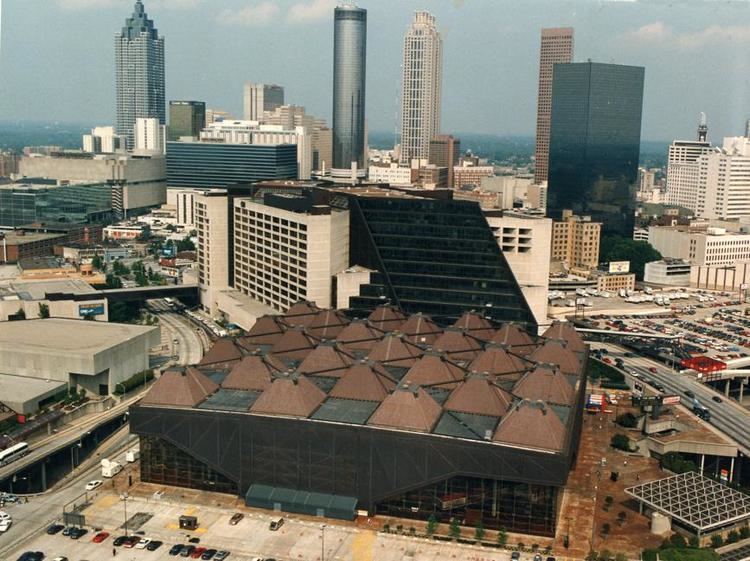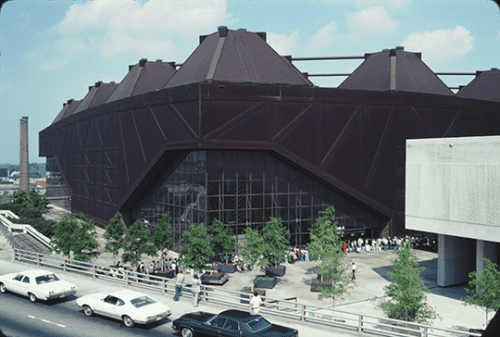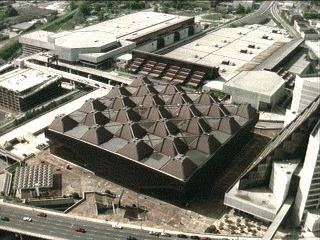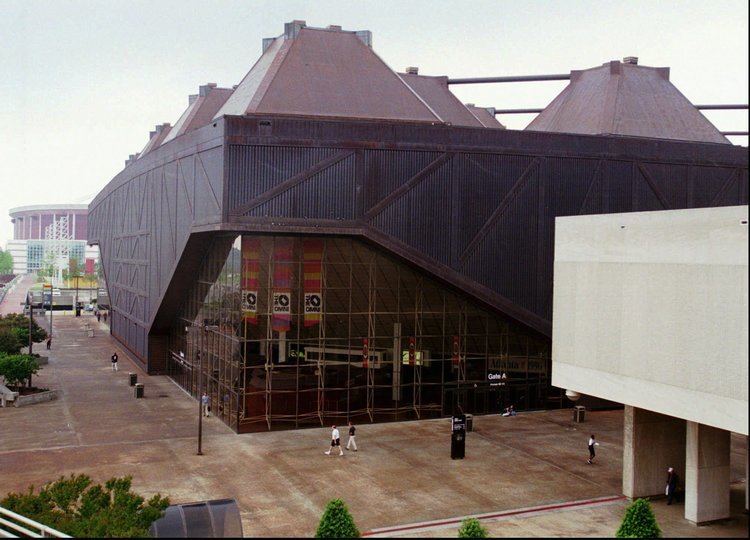Demolished 26 July 1997 | Broke ground March 30, 1971 Opened 14 October 1972 Owner Atlanta | |
Capacity Basketball:16,181 (1972–1977),16,400 (1977–1984),16,522 (1984–1987),16,451 (1987–1988),16,371 (1988–1990),16,390 (1990–1991),16,425 (1991–1992),16,441 (1992–1993),16,368 (1993–1994),16,378 (1994–1997)hockey:15,078 (1972–1973),15,141 (1973–1977),15,155 (1977–1983),15,278 (1984–1997) Construction cost $17 million($97.3 million in 2017 dollars) Similar McNichols Sports Arena, Capital Centre, Richfield Coliseum, Market Square Arena, CNN Center | ||
Omni coliseum implosion
Omni Coliseum (often called The Omni) was an indoor arena in Atlanta, Georgia, United States. Completed in 1972, the arena seated 16,378 for basketball and 15,278 for Hockey. It was part of the Omni Complex, now known as the CNN Center.
Contents
- Omni coliseum implosion
- History
- Scoreboard
- Professional wrestling
- Basketball and hockey
- Indoor soccer
- Concerts
- Problems
- References

It was mainly used as the home arena for the Atlanta Hawks (NBA) and the Atlanta Flames (NHL). It also hosted the 1977 NCAA Men's Division I Basketball Tournament and the 1996 Summer Olympics indoor volleyball.

History

The arena was considered an architectural marvel that combined innovative roof, seating, and structural designs. The logo is based on the unique seating arrangement. The exterior was made of Cor-Ten weathering steel, which was supposed to seal itself by continuing to rust, making a solid steel structure that would last for decades. The Omni was noted for its distinctive space frame roof, often joked about as looking like an egg crate or a rusty waffle iron. Designed by the firm of tvsdesign with structural engineering work by the firm of Prybylowski and Gravino, the roof was technically described as an ortho-quad truss system.
Scoreboard

The only remaining part of the Omni is the scoreboard that hangs in the pavilion of the Philips Arena. American Sign and Indicator built the basketball-specific scoreboard in the early 1990s to replace the original hockey-specific scoreboard that Daktronics maintained during the 1980s. The arena also had four message boards on each end zone, two of which were animation boards.
Professional wrestling

The Omni was a hotbed for professional wrestling. It was considered the home base for the NWA's Georgia Championship Wrestling since its opening, Jim Crockett Promotions in the late 1980s, and WCW. Many major and historic wrestling events tool place at the Omni, including Starrcade 85, Starrcade 86, Starrcade 89, the first Wargames match during the Great American Bash in 1987, and many other pay-per-view shows. The WWE also held many shows at the Omni when they were known as the WWF.
Basketball and hockey
The Omni was home to the NBA Atlanta Hawks from 1972 to 1997; their final game at the Omni was during the 1997 NBA Playoffs Eastern Conference Semifinals against the Chicago Bulls (Game 4) on May 11, 1997; they lost 89-80. The Omni was also home of the NHL Atlanta Flames from 1972 to 1980 (now the Calgary Flames), and the IHL Atlanta Knights (1992–1996). In 1994, the Knights became the only pro team to win a championship in the building when they won the Turner Cup.
The arena also hosted the 1977 NCAA Final Four, won by Marquette University over North Carolina in what was Warriors' (their nickname at the time, now known as the Golden Eagles) coach Al McGuire's last game, one SEC and three ACC men's basketball tournaments, the 1978 NBA All-Star Game, the 1993 NCAA Women's Basketball Final Four, and the indoor volleyball matches for the 1996 Summer Olympics.
Indoor soccer
The Omni was the indoor home of the Atlanta Chiefs of the North American Soccer League as well as the Atlanta Attack of the American Indoor Soccer Association.
Concerts
Many other concerts were held at the arena, including Madonna, Bruce Springsteen, U2, Garth Brooks, Rod Stewart, Bon Jovi, Whitney Houston, Prince, and The Commodores.
Among the major non-sports events at the Omni was the 1988 Democratic National Convention where delegates nominated Michael Dukakis and Lloyd Bentsen for President and Vice President of the United States, respectively.
Problems
The Omni did not last nearly as long as many other arenas built during the same time period, in part because a number of its innovations did not work as intended. The most serious problem was the weathering steel that was designed to form a protective seal around the building. However, Atlanta's humid subtropical climate put so much stress on the steel that it never stopped rusting. By the 1980s, the steel had so badly deteriorated that large holes began appearing. Chain link fences were installed to keep people from crawling through the wall to see events. Despite fairly good sight lines, the structure had begun to look dated by the early 1990s (although the arena was only 20 years old).
Built on a former railroad yard, it settled more than its designers expected after construction. There were unanticipated stresses in the space frame roof, which often leaked water.
In the late 1980s and early 1990s, a growing number of NBA and NHL teams began to construct arenas with better amenities for their high-end customers, such as luxury boxes, club-level seating, and massive club concourses, to increase revenue. Some of these new arenas had as many as 200 luxury boxes. By comparison, the Omni had only 16 luxury boxes and no club level. It also became a disadvantage to the city of Atlanta; until the Georgia Dome was finished in 1992, the Omni served as its largest indoor facility in terms of seating capacity.
Although the Omni hosted many events, it lost more than its share due to the smaller Capacity and lack of amenities compared to newer buildings in other cities. By the start of the 1990s, an effort began to build a replacement. A new arena would have likely been needed in any event due to the Omni's structural problems. This also stemmed from Ted Turner's desire to own an NHL franchise; the Flames had been sold to Canadian businessmen and relocated to Calgary, Alberta a decade earlier. The NHL determined the Omni was not suitable even as a temporary facility, and would only grant Atlanta an expansion team if Turner guaranteed a brand-new arena would be in place by the time the new team took the ice. On July 26, 1997, the Omni was demolished, and Philips Arena, which was constructed on the site, opened on September 18, 1999.
